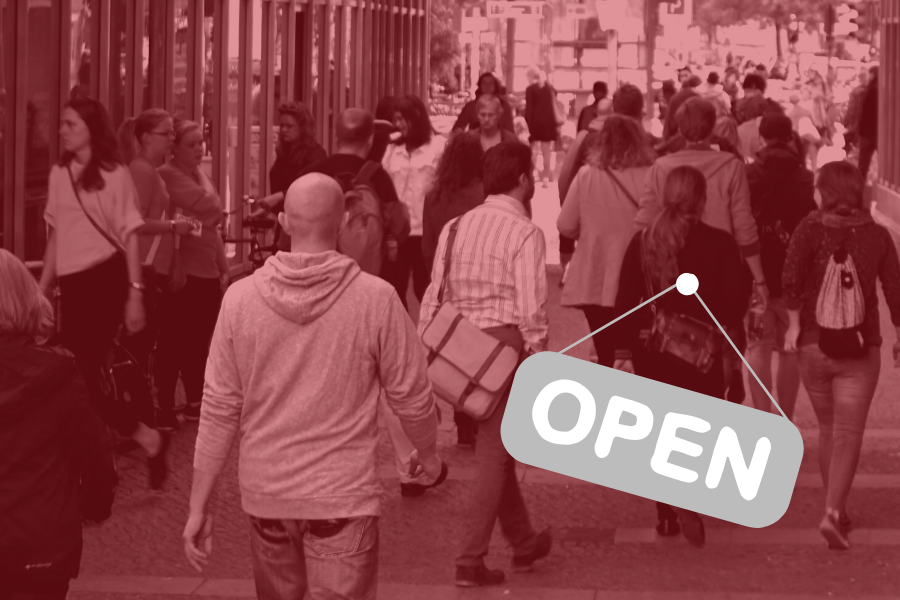
Yes – It Is All About Process and Operations When It Comes to Reopening Our Economy
*The opinions and thoughts expressed in this article are my own and not necessarily those of my employers or any other individuals.
The coronavirus (COVID-19) has stalled the economy and affected nearly every living being on this planet. The approach to slow the rate of progression of the virus through social distancing seems to be working as the number of daily cases are decreasing. Anticipating the new normal, everyone is excited about the possibility of the U.S, economy opening for business very soon. Several states are exploring the possibility of this happening as early as May 1. While the need to reopen the American economy, which is predominantly service-based, is completely understandable, we need to think more on what this opening means and how to prevent a second surge.
Being a process researcher, there are a few things that are important to consider from a systemic point of view as we think about this big opening day.
First, the biggest factor deciding the full functioning of our economy is the individual states’ and cities’ ability to manage any surges of new cases through proper testing and hospitalization. It’s been stated that 20 million to 30 million tests need to be done every day for us to return to normal. My fear is that this estimate may be low. As an example, consider South Korea, which conducted an average of 10,700 tests per million citizen and was often cited as a good example of containment. The U.S. also has a very similar number of 10,800 tests per million which, on the surface, may suggest we are doing well. However, we are seeing a second surge of cases appearing in South Korea for patients who tested positive after recovery despite good testing procedures. The testing per million cases in the U.S. varies by states. It is high in states like New York (about 29,000 per million) and low in other highly populous regions like California (about 6,200 per million). When the economy opens, more pressure will be on testing and diagnosis, and one recommendation is to manage the opening process as a function of the testing ability. So, states with lower testing per million and high population should be very cautious when thinking about the opening process. It is also important to look at neighboring states and their testing capabilities when making decisions. For instance, Rhode Island has fewer cases but shares borders with Massachusetts and New York. Even with restricted travel across states, Rhode Island is more likely to see a surge in cases when the economy reopens.
On a similar note, regions also have to estimate the ability to offer hospitalization services for patients needing care for COVID-19. We have seen struggles in New York even under stay-at-home orders. I have heard from colleagues and friends working in several healthcare systems around the U.S. about the inability to effectively offer care to these patients – all of whom work in states with strict stay-at-home orders to contain the spread.
As the economy reopens, hospitals will see other patients, conduct revenue-generating elective procedures and utilize other resources. We may need to think about how much to allocate as fixed resources for anticipated COVID-19 cases (number of beds, ventilators, essential supplies, etc.). We have already seen the amazing work of our healthcare providers during the crisis. As we think about reopening, we may need to guard against their health and safety (including psychological stress) to ensure individual cities and regions are ready to manage any second surges. The amount of resources required will be determined by the testing per million, influx into the region and the population density. Once again, it is better to be over-prepared with more resources early enough to avoid spreading. The decision to allocate resources may have to be made on a daily basis with zip-code-level data – which can create a nightmare scenario for hospital scheduling. But this is absolutely essential to avoid any future surges.
Moving away from healthcare, there are other important issues to consider. We have already seen social distancing and the use of masks and other shopping across several stores. This is an excellent practice that must continue for the next several months. Restricting population within a store has several benefits, even when the economy is open. It minimizes the possibility of transmissions, provides more time to clean between shoppers and, most importantly, it protects frontline workers who are exposed to numerous shoppers. Similar restrictions should also be practiced in public gyms. One approach to practice could be pre-reservations and channeling traffic to different times during the day, something I have seen practiced in good service industries. Managing the waiting and arrival times in these public places can go a long way in containing the spread.
How about educational systems? Well, for universities, several strategies can be helpful. First, looking at offerings that may require a physical presences (e.g. lab studies, in-person conversations, etc.), and opening softly for these services can help restrict crowds. We already know that almost every university in the U.S. has made summer classes online, thereby restricting crowds in these areas. Additional steps to prevent spread or future outbreaks can include staggered schedules, adopting alternate day schedules for different colleges and creating larger breaks between in-person classes and labs during the summer to manage the spread. As they learn from these soft openings, universities can increase or adjust the flow for the fall semester. Conducting quick experimentation in the summer rather than having essential classes may be better than postponing any activity until the fall semester. This allows the institution and its population to learn and adjust accordingly before entertaining larger groups of students on campus.
In the case of K-12 education, several states have closed schools for the year. Being a parent of an elementary school kid, I can certainly empathize with several million parents who are multitasking work, life and home-schooling. As we think about the open of the next academic year, I would encourage piloting small programs before larger crowds. These could include regulated summer sessions with staggered schedules, having some classes in summer, or optional or extra-curricular education just to provide administrators the opportunity to understand the load on the system. Social distancing will be difficult to practice among elementary school kids; alternative strategies to understand the load on the system and how to manage cleaning processes will be important to understand before schools are fully operational.
We all want to go back to our normal lives. But let us also keep in mind that the U.S. may not be ready for another complete lockdown. The principles of good operations management such as starting slow, learning frequently from data and adjusting, being over-prepared and putting our employees’ safety first are absolutely essential for the path to lasting recovery.







